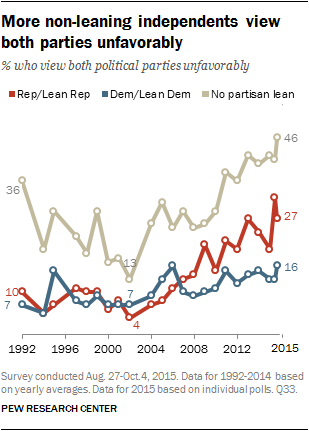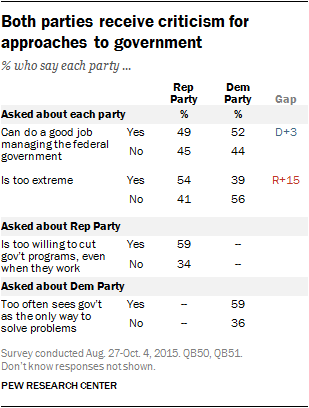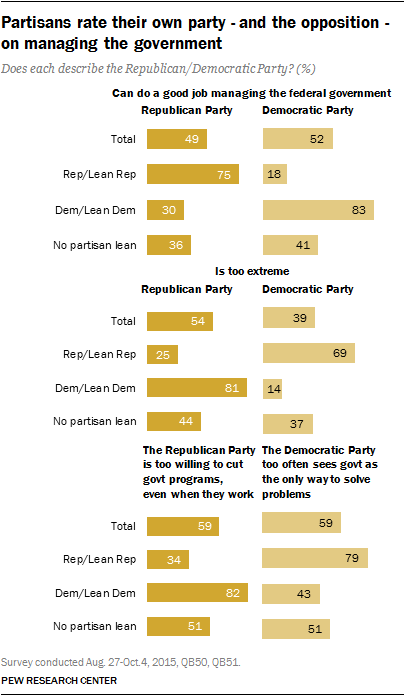The public continues to view the Democratic Party more favorably than the Republican Party. But neither party has a significant advantage when it comes to opinions about which could better manage the federal government.
In addition, both parties are criticized for how they deal with the size and scope of government. Nearly six-in-ten (59%) say the Republican Party is too willing to cut government programs even when they work. An identical percentage says the Democratic Party too often sees government as the only way to solve problems.
The favorable rating for the Democratic Party has changed little since the start of the year: Currently, 45% view the Democratic Party favorably, while 50% view it unfavorably. Meanwhile, the GOP’s image has improved somewhat since July, when just 32% viewed the party favorably – among the lowest favorability ratings in two decades of polling. Still, in the current survey, just 37% view the Republican Party favorably, while 58% view it unfavorably. 
The percentage saying they have unfavorable views of both parties has been growing in recent years. Fully 24% now say they have unfavorable views of both parties, up from 12% in 2008 and just 6% in 2002.
Most of the growth in unfavorable opinions of both parties has come among Republicans and Republican-leaning independents, and among the 13% of the public that does not lean to either political party.
About a quarter of Republicans and Republican leaners (27%) say they have an unfavorable opinion of both parties. That is down slightly from July (32%) but one of the highest percentages since 1992. By comparison, just 16% of Democrats and Democratic leaners have a negative opinion of both parties.
Independents without partisan leanings are the group most likely to have negative views of both parties. Close to half (46%) of non-leaning independents now say they have an unfavorable view of both the Republican and Democratic parties. That is almost double the percentage who said this in 2008 (25%).
 Nonetheless, Republicans and Republican leaners make up the largest share of those who view both parties unfavorably. Close to half (45%) of those who have unfavorable views of both parties are Republicans or Republican leaners; 30% are Democrats or Democratic leaners, while 25% are independents who do not lean toward either party.
Nonetheless, Republicans and Republican leaners make up the largest share of those who view both parties unfavorably. Close to half (45%) of those who have unfavorable views of both parties are Republicans or Republican leaners; 30% are Democrats or Democratic leaners, while 25% are independents who do not lean toward either party.
Predictably, those who have a favorable view of one party and an unfavorable one of the other are overwhelmingly partisans and partisan leaners. Among the small share of the public (11%) that sees both parties favorably, Democrats make up the largest share (48%).
Views of the parties’ approaches to government
The public has similar views of each party’s ability to manage the federal government. About half (52%) say the Democratic Party can do a good job managing the federal government, while 44% say it cannot. A comparable percentage (49%) says the Republican Party can do a good job of managing the government, while 45% disagree. 
As in the past, more Americans view the Republican Party as “too extreme” (54%) than say that description applies to the Democratic Party (39%).
The survey also asks about specific criticisms of the parties’ approaches to governing. A majority (59%) says that the Democratic Party “too often sees government as the only way to solve problems,” while an identical percentage says that the Republican Party “is too willing to cut government programs, even when they work.”
As might be expected, Republicans and Democrats in large numbers give their own party positive ratings for dealing with the federal government.
Most Democrats and Democratic leaners (83%) say the Democratic Party can do a good job managing the government, compared with just 30% who say the Republican Party could do a good job. Among Republicans, 75% say their own party could manage the government effectively, while just 18% say the same about the Democratic Party.
However, Republicans are more likely to view the GOP as “too extreme” than Democrats are to say the same about their own party. A quarter of Republicans say the GOP is too extreme; 14% of Democrats say the same of their party.
When asked if the Democratic Party too often sees government as the solution to problems, 43% of Democrats and Democratic leaners say this is the case. When asked to judge whether the GOP is too quick to cut working programs, a somewhat smaller share of Republicans and Republican leaners (34%) say this is true of their party.
To be sure, much larger proportions of Republicans and Democrats are critical of the other party in assessing these characteristics. About seven-in-ten Republicans (69%) say that the Democratic Party is too extreme and an overwhelming majority of Democrats say that the GOP is too extreme (81%). Similarly, about eight-in-ten Republicans (79%) say that the Democratic Party too often relies on government solutions, while 82% of Democrats say that the Republican Party is too quick to cut effective programs.
For their part, independents who do not lean to either party offer similar assessments of the Republican and Democratic parties on all of the items tested. On the critiques of each party’s approach to government, for instance, non-leaning independents are as likely to say that the GOP is too quick to cut effective government programs as they are to say that the Democratic Party is too reliant on government to solve problems (51% each).
Among the 22% of the public that is angry with the federal government – a largely Republican group – 44% say, in effect, that only the GOP can do well in managing the government; they say the Republicans can do well and the Democrats cannot. Yet nearly a third of those angry at government (31%) say neither party can do well in managing the federal government. Relatively few say the Democratic Party, but not the Republican Party, can do a good job managing the government (16%).
Among the majority of the public (57%) that is frustrated with government, there is no clear preference about which party can do better in management. Among those who are “basically content” with the government (18% of the public), 44% say the Democratic Party, but not the Republicans, can do well in managing the government, while 36% say both parties can do a good job and just 11% say the Republican Party, but not the Democratic Party, can do a good job running the government.
Differences between the two major parties
 The share of Americans who say there are major differences between the political parties, while little changed from early last year, remains as high as it has ever been.
The share of Americans who say there are major differences between the political parties, while little changed from early last year, remains as high as it has ever been.
Currently, 45% say there is “a great deal” of difference in what the parties stand for; 32% say there is a “fair amount” of difference and 19% say there is “hardly any difference” between the Republican and Democratic parties. The share saying there are wide differences between the parties is as high as it has been in the past three decades.
 Conservative Republicans and Republican leaners (51%) are more likely than the party’s moderates and liberals (40%) to see a great deal of difference between the parties. Among Democrats and Democratic leaners, 52% of liberals say there are big differences between the parties, compared with 44% of moderate and conservative Democrats.
Conservative Republicans and Republican leaners (51%) are more likely than the party’s moderates and liberals (40%) to see a great deal of difference between the parties. Among Democrats and Democratic leaners, 52% of liberals say there are big differences between the parties, compared with 44% of moderate and conservative Democrats.
Among independents who do not lean to a party, just 31% say there are big differences between the parties; nearly as many (33%) say there are hardly any differences.
Overall, a majority (56%) of politically engaged adults say there are substantial differences between the parties, compared with 38% of those who are less politically engaged.
Most see a politically divided nation
An overwhelming majority of Americans say that the country is now more politically divided than in the past – and few expect these divisions to go away anytime soon.
Currently, 79% view the country as more politically divided, little different from surveys in 2013 (81%) and 2012 (80%), but as high as at any point since the question was first asked more than 10 years ago. In January 2009, shortly before Barack Obama took office, just 46% said the country was more politically divided than it had been in the past.
When asked to look five years ahead, 78% say that either the country will be just as politically divided as it is now (42%), or more divided (36%).
There is broad agreement across partisan and demographic groups that the country is more politically divided, and that these divisions will persist – or deepen – over the next five years.
Comparable percentages of Republicans and Republican leaners (82%) and Democrats and Democratic leaners (78%) say that the country is more politically divided than in the past. A slightly smaller share of those who do not lean toward either party (72%) say the same.


 Interactive
Interactive